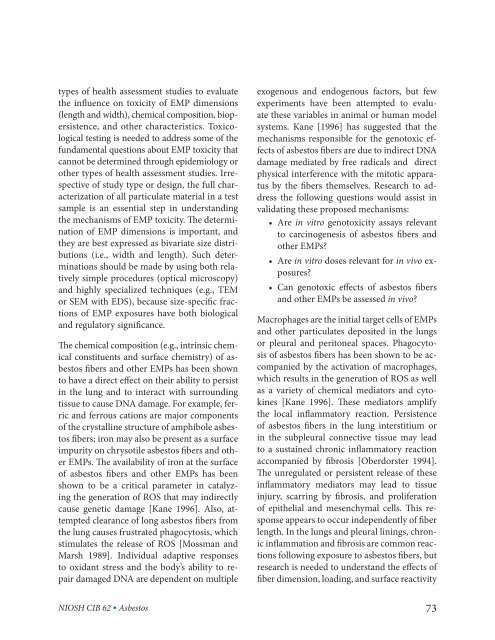Asbestos Fibers and Other Elongate Mineral Particles: State of the ...
Asbestos Fibers and Other Elongate Mineral Particles: State of the ...
Asbestos Fibers and Other Elongate Mineral Particles: State of the ...
- No tags were found...
You also want an ePaper? Increase the reach of your titles
YUMPU automatically turns print PDFs into web optimized ePapers that Google loves.
types <strong>of</strong> health assessment studies to evaluate<br />
<strong>the</strong> influence on toxicity <strong>of</strong> EMP dimensions<br />
(length <strong>and</strong> width), chemical composition, biopersistence,<br />
<strong>and</strong> o<strong>the</strong>r characteristics. Toxicological<br />
testing is needed to address some <strong>of</strong> <strong>the</strong><br />
fundamental questions about EMP toxicity that<br />
cannot be determined through epidemiology or<br />
o<strong>the</strong>r types <strong>of</strong> health assessment studies. Irrespective<br />
<strong>of</strong> study type or design, <strong>the</strong> full characterization<br />
<strong>of</strong> all particulate material in a test<br />
sample is an essential step in underst<strong>and</strong>ing<br />
<strong>the</strong> mechanisms <strong>of</strong> EMP toxicity. The determination<br />
<strong>of</strong> EMP dimensions is important, <strong>and</strong><br />
<strong>the</strong>y are best expressed as bivariate size distributions<br />
(i.e., width <strong>and</strong> length). Such determinations<br />
should be made by using both relatively<br />
simple procedures (optical microscopy)<br />
<strong>and</strong> highly specialized techniques (e.g., TEM<br />
or SEM with EDS), because size-specific fractions<br />
<strong>of</strong> EMP exposures have both biological<br />
<strong>and</strong> regulatory significance.<br />
The chemical composition (e.g., intrinsic chemical<br />
constituents <strong>and</strong> surface chemistry) <strong>of</strong> asbestos<br />
fibers <strong>and</strong> o<strong>the</strong>r EMPs has been shown<br />
to have a direct effect on <strong>the</strong>ir ability to persist<br />
in <strong>the</strong> lung <strong>and</strong> to interact with surrounding<br />
tissue to cause DNA damage. For example, ferric<br />
<strong>and</strong> ferrous cations are major components<br />
<strong>of</strong> <strong>the</strong> crystalline structure <strong>of</strong> amphibole asbestos<br />
fibers; iron may also be present as a surface<br />
impurity on chrysotile asbestos fibers <strong>and</strong> o<strong>the</strong>r<br />
EMPs. The availability <strong>of</strong> iron at <strong>the</strong> surface<br />
<strong>of</strong> asbestos fibers <strong>and</strong> o<strong>the</strong>r EMPs has been<br />
shown to be a critical parameter in catalyzing<br />
<strong>the</strong> generation <strong>of</strong> ROS that may indirectly<br />
cause genetic damage [Kane 1996]. Also, attempted<br />
clearance <strong>of</strong> long asbestos fibers from<br />
<strong>the</strong> lung causes frustrated phagocytosis, which<br />
stimulates <strong>the</strong> release <strong>of</strong> ROS [Mossman <strong>and</strong><br />
Marsh 1989]. Individual adaptive responses<br />
to oxidant stress <strong>and</strong> <strong>the</strong> body’s ability to repair<br />
damaged DNA are dependent on multiple<br />
NIOSH CIB 62 • <strong>Asbestos</strong><br />
exogenous <strong>and</strong> endogenous factors, but few<br />
experiments have been attempted to evaluate<br />
<strong>the</strong>se variables in animal or human model<br />
systems. Kane [1996] has suggested that <strong>the</strong><br />
mechanisms responsible for <strong>the</strong> genotoxic effects<br />
<strong>of</strong> asbestos fibers are due to indirect DNA<br />
damage mediated by free radicals <strong>and</strong> direct<br />
physical interference with <strong>the</strong> mitotic apparatus<br />
by <strong>the</strong> fibers <strong>the</strong>mselves. Research to address<br />
<strong>the</strong> following questions would assist in<br />
validating <strong>the</strong>se proposed mechanisms:<br />
• Are in vitro genotoxicity assays relevant<br />
to carcinogenesis <strong>of</strong> asbestos fibers <strong>and</strong><br />
o<strong>the</strong>r EMPs?<br />
• Are in vitro doses relevant for in vivo exposures?<br />
• Can genotoxic effects <strong>of</strong> asbestos fibers<br />
<strong>and</strong> o<strong>the</strong>r EMPs be assessed in vivo?<br />
Macrophages are <strong>the</strong> initial target cells <strong>of</strong> EMPs<br />
<strong>and</strong> o<strong>the</strong>r particulates deposited in <strong>the</strong> lungs<br />
or pleural <strong>and</strong> peritoneal spaces. Phagocytosis<br />
<strong>of</strong> asbestos fibers has been shown to be accompanied<br />
by <strong>the</strong> activation <strong>of</strong> macrophages,<br />
which results in <strong>the</strong> generation <strong>of</strong> ROS as well<br />
as a variety <strong>of</strong> chemical mediators <strong>and</strong> cytokines<br />
[Kane 1996]. These mediators amplify<br />
<strong>the</strong> local inflammatory reaction. Persistence<br />
<strong>of</strong> asbestos fibers in <strong>the</strong> lung interstitium or<br />
in <strong>the</strong> subpleural connective tissue may lead<br />
to a sustained chronic inflammatory reaction<br />
accompanied by fibrosis [Oberdorster 1994].<br />
The unregulated or persistent release <strong>of</strong> <strong>the</strong>se<br />
inflammatory mediators may lead to tissue<br />
injury, scarring by fibrosis, <strong>and</strong> proliferation<br />
<strong>of</strong> epi<strong>the</strong>lial <strong>and</strong> mesenchymal cells. This response<br />
appears to occur independently <strong>of</strong> fiber<br />
length. In <strong>the</strong> lungs <strong>and</strong> pleural linings, chronic<br />
inflammation <strong>and</strong> fibrosis are common reactions<br />
following exposure to asbestos fibers, but<br />
research is needed to underst<strong>and</strong> <strong>the</strong> effects <strong>of</strong><br />
fiber dimension, loading, <strong>and</strong> surface reactivity<br />
73

















